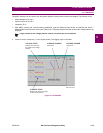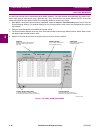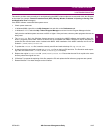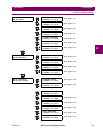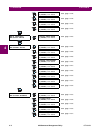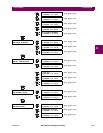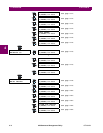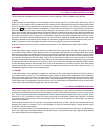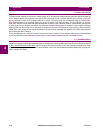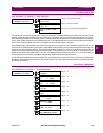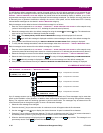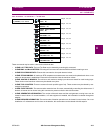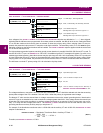
GE Multilin 489 Generator Management Relay 4-5
4 SETPOINTS 4.1 OVERVIEW
4
4.1.2 TRIPS / ALARMS/ CONTROL FEATURES
The 489 Generator Management Relay has three basic function categories: TRIPS, ALARMS, and CONTROL.
a) TRIPS
A 489 trip feature may be assigned to any combination of the four output relays: R1 Trip, R2 Auxiliary, R3 Auxiliary, and R4
Auxiliary. If a Trip becomes active, the appropriate LED (indicator) on the 489 faceplate illuminates to indicate which output
relay has operated. Each trip feature may be programmed as latched or unlatched. Once a latched trip feature becomes
active, the key must be pressed to reset that trip. If the condition that caused the trip is still present (for example, hot
RTD) the trip relay(s) will not reset until the condition disappears. On the other hand, if an unlatched trip feature becomes
active, that trip resets itself (and associated output relay(s)) after the condition that caused the trip ceases and the Breaker
Status input indicates that the breaker is open. If there is a lockout time, the trip relay(s) will not reset until the lockout time
has expired. Immediately prior to issuing a trip, the 489 takes a snapshot of generator parameters and stores them as pre-
trip values, allowing for troubleshooting after the trip. The cause of last trip message is updated with the current trip and the
489 display defaults to that message. All trip features are automatically logged and date and time stamped as they occur. In
addition, all trips are counted and logged as statistics such that any long term trends may be identified.
Note that a lockout time will occur due to overload trip (see Section 4.10.2: Model Setup on page 4–56 for details).
b) ALARMS
A 489 alarm feature may be assigned to operate any combination of four output relays: R5 Alarm, R4 Auxiliary, R3 Auxil-
iary, and R2 Auxiliary. When an Alarm becomes active, the appropriate LED (indicator) on the 489 faceplate will illuminate
when an output relay(s) has operated. Each alarm feature may be programmed as latched or unlatched. Once a latched
alarm feature becomes active, the reset key must be pressed to reset that alarm. If the condition that has caused the alarm
is still present (for example, hot RTD) the Alarm relay(s) will not reset until the condition is no longer present. If on the other
hand, an unlatched alarm feature becomes active, that alarm will reset itself (and associated output relay(s)) as soon as the
condition that caused the alarm ceases. As soon as an alarm occurs, the alarms messages are updated to reflect the alarm
and the 489 display defaults to that message. Since it may not be desirable to log all alarms as events, each alarm feature
may be programmed to log as an event or not. If an alarm is programmed to log as an event, when it becomes active, it is
automatically logged as a date and time stamped event.
c) CONTROL
A 489 control feature may be assigned to operate any combination of five output relays: R5 Alarm, R4 Auxiliary, R3 Auxil-
iary, and R2 Auxiliary, and R1 Trip. The combination of relays available for each function is determined by the suitability of
each relay for that particular function. The appropriate LED (indicator) on the 489 faceplate will illuminate when an output
relay(s) has been operated by a control function. Since it may not be desirable to log all control function as events, each
control feature may be programmed to log as an event or not. If a control feature is programmed to log as an event, each
control relay event is automatically logged with a date and time stamp.
4.1.3 RELAY ASSIGNMENT PRACTICES
There are six output relays. Five of the relays are always non-failsafe, the other (Service) is failsafe and dedicated to
annunciate internal 489 faults (these faults include setpoint corruption, failed hardware components, loss of control power,
etc.). The five remaining relays may be programmed for different types of features depending on what is required. One of
the relays, R1 Trip, is intended to be used as a trip relay wired to the unit trip breaker. Another relay, R5 Alarm, is intended
to be used as the main alarm relay. The three remaining relays, R2 Auxiliary, R3 Auxiliary, and R4 Auxiliary, are intended
for special requirements.
When assigning features to R2, R3, and R4 it is a good idea to decide early on what is required since features that may be
assigned may conflict. For example, if R2 is to be dedicated as a relay for sequential tripping, it cannot also be used to
annunciate a specific alarm condition.
In order to ensure that conflicts in relay assignments do not occur, several precautions have been taken. All trips default to
the R1 Trip output relay and all alarms default to the R5 Alarm relay. It is recommended that relay assignments be reviewed
once all the setpoints have been programmed.
RESET



